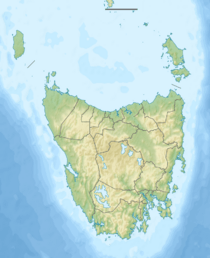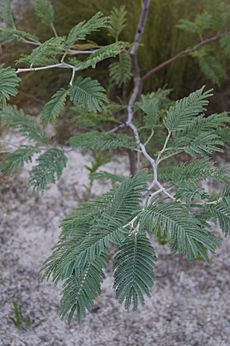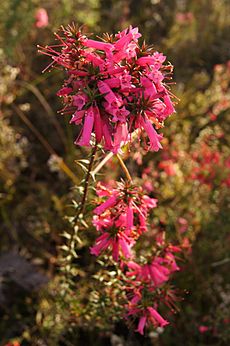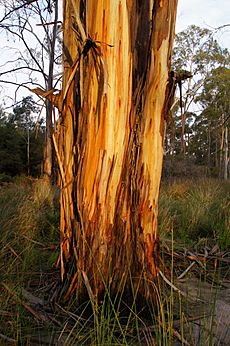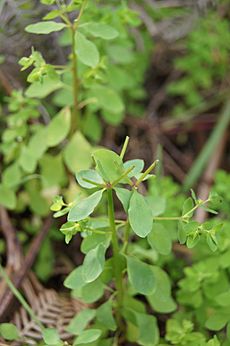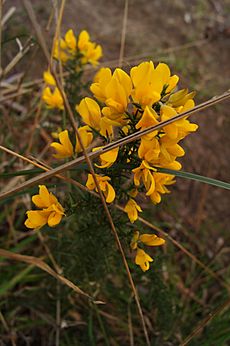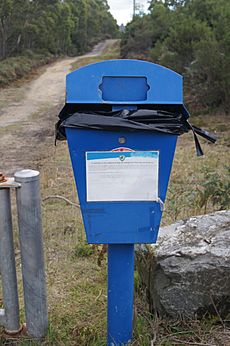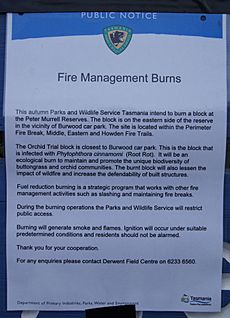Peter Murrell Conservation Area facts for kids
Quick facts for kids Peter Murrell Conservation AreaHuntingfield, Tasmania |
|
|---|---|
|
IUCN Category V (Protected Landscape/Seascape)
|
|
| Nearest town or city | Hobart |
| Established | 8 December 1999 |
| Area | 1.35 km2 (0.5 sq mi) |
| Managing authorities | Tasmanian Parks and Wildlife Service |
| Website | Peter Murrell Conservation Area |
| See also | Protected areas of Tasmania |
The Peter Murrell Conservation Area is a special natural space in Huntingfield, Tasmania. It's about 15 kilometers (9 miles) south of Hobart, the capital city. This area covers 135 hectares (about 334 acres) and is part of a larger group called the Peter Murrell Reserves. These reserves also include the Peter Murrell State Reserve and a Public Reserve. They are located near the Tinderbox Peninsula, between the towns of Kingston, Howden, and Blackman's Bay.
Contents
What is the Peter Murrell Conservation Area?
The Peter Murrell Conservation Area is in Southern Tasmania, within the Derwent Estuary – Bruny Catchment. It has many small creeks and streams. These waterways collect water from a large area, including places like South Arm and Bruny Island. The North West Bay River is the main river in this area. It flows from Mt. Wellington into North West Bay, which is near the conservation area.
This conservation area is part of the South East Tasmania Bioregion. A bioregion is a large area of Australia that shares a similar climate, geology, land, plants, and animals. It helps us understand and protect Australia's natural places.
Amazing Plants and Animals
Plants (Flora)
The Peter Murrell Conservation Area is home to many interesting plants. You'll mostly find dry heathlands and forests with black peppermint trees. Some areas also have buttongrass, which grows in wet, peaty soil. In total, nine main types of plant communities have been found here.
More than 250 native flowering plants grow in this area. That's about 15% of all flowering plants in Tasmania! Thirteen of these plants are endemic, meaning they are only found in Tasmania. The area also has 113 introduced plant species, but only a few are problem weeds. In late winter and early spring, many wattle and pea shrubs create beautiful, colorful displays.
This conservation area is famous for its orchids. It has 37 different orchid species, one of the highest numbers in all of Tasmania! Five of these orchid species are endemic to Tasmania, like the trim leek-orchid and the dark-finger-orchid. Sadly, the number of orchids has been going down recently. This might be because of how often fires happen, or if there's not enough rain after controlled burns.
Two plant species in the area are considered threatened: the twisting rapier sedge and the gentle rush. Both are listed as rare in Tasmania.
Animals (Fauna)
Mammals
In 2010, 13 mammal species were reported in the Peter Murrell Conservation Area. Other reports suggest there could be up to 24 mammal species, with 19 being native to Tasmania. Some animals, like platypuses, haven't been seen there since 2010.
Native mammals you might find include:
- Short-beaked echidna
- Eastern quoll
- Southern brown bandicoot
- Eastern barred bandicoot
- Common ringtail possum
- Sugar glider
- Common brushtail possum
- Long-nosed potoroo
- Tasmanian bettong
- Tasmanian pademelon
- Bennett's wallaby
- Several types of bats (Gould's wattled bat, chocolate wattled bat, lesser long-eared bat, southern forest bat, little forest bat)
- Water rat
- Swamp rat
Five introduced mammals have also been seen: cats, house mice, brown rats, black rats, and European rabbits.
The eastern barred bandicoot is a small marsupial that lives here. It is listed as vulnerable under Australia's environmental laws. This means it's at risk of disappearing. These bandicoots can have many babies, up to five litters a year. Their numbers have dropped a lot on mainland Australia, mainly because of foxes. While Tasmanian populations are stronger, they are also thought to be declining.
Birds
The Peter Murrell Reserves are a fantastic spot for bird-watching! Over 100 bird species have been recorded here. It's one of the last places where you can find the endangered Forty-spotted Pardalote. Look for them in white gum trees, especially near the car park and ponds.
Other birds you might see include:
- Australian wood duck
- Pacific black duck
- Chestnut teal
- Hoary-headed grebe
- Brown quail
- Common bronzewing
- Cuckoos
- Tawny frogmouth
- Tasmanian native hen
- Eurasian coot
- Australasian swamphen
- Masked lapwing
- Swamp harrier
- Laughing kookaburra
- Yellow-tailed black-cockatoo
- Green rosella
- Superb fairywren
- Eastern spinebill
- Little wattlebird
- Yellow wattlebird
- Honeyeaters
- Pardalotes
- Striated fieldwren
- Brown thornbill
- Black-faced cuckoo shrike
- Grey shrike thrush
- Golden whistler
- Dusky wood swallow
- Grey butcherbird
- Australian magpie
- Grey currawong
- Grey fantail
- Satin flycatcher
- Forest raven
- Scarlet robin
- Dusky robin
- Welcome swallow
- European goldfinch
Invertebrates, Reptiles, and Amphibians
Scientists haven't recently studied all the insects, reptiles, and amphibians in the area. However, studies from the late 1990s found six reptile species, three amphibian species, and 151 invertebrate species.
The chaostola skipper, a type of butterfly, is endangered in Tasmania. Its habitat has shrunk a lot over the last 200 years. This loss of habitat is the main reason its numbers are declining. Twelve other insect species in the Peter Murrell Conservation Area are also considered rare or endemic.
Land and Rocks
The ground in the Peter Murrell Conservation Area is made of sandstone, siltstone, and mudstone. The soils are usually sandy and drain water well on sloped areas. There are also two ponds, Penrhyn and Heron ponds, in the northwest part of the area.
Challenges and Threats
Land Use and Development
The Peter Murrell Conservation Area is in Kingborough, an area with many homes and businesses. Because of this, new buildings and developments are a big threat to the conservation area. For example, a proposed housing development nearby could put pressure on the environment.
Stormwater management is also a problem. A lot of dirt and mud washes into Coffee Creek, harming native plants and animal homes. This means that even building upstream (further away) can affect the conservation area. Waterways here are very sensitive to pollution and dirt.
Introduced Species
Many invasive plants threaten the native plants in the Peter Murrell Conservation Area. These include gorse, Spanish heath, English broom, and blackberry. Invasive species can take over, pushing out native plants and harming the natural balance.
A serious plant disease called root rot (Phytophthora cinnamomi) is also present. This disease can kill plants and destroy habitats. It's a "Key Threatening Process" under Australian law. It especially threatens the buttongrass and orchid communities in the area.
How the Area is Managed
Laws and Rules
The Peter Murrell Conservation Area is protected by several important laws. These include the National Parks and Reserves Management Act and the Nature Conservation Act. The Threatened Species Protection Act 1995 helps protect endangered plants and animals. The Aboriginal Relics Act 1975 protects important Aboriginal heritage sites in the area. Other laws, like the Land Use Planning and Approvals Act 1994 and the national EPBC Act 1999, also help guide how the area is managed.
General Management
The Peter Murrell Reserves are managed as one big area by the Tasmanian Parks and Wildlife Service (TPWS). A small part of the area is leased by the Huntingfield Pony and Riding Club, which helps with fire control. The TPWS is in charge of managing the plants.
The area is zoned as 'Environmental Management'. This means the goal is to protect natural and cultural resources, like plants, animals, landscapes, and heritage sites. It also aims to prevent too much building between towns.
The TPWS does many things to manage the area. They provide facilities like car parks and bins for dog waste. They also have special areas for different uses. For example, there's a horse riding trail around the edges of the conservation area. There are also special fire trails.
One important management action is using controlled fires to fight root rot. These fires help protect the plants, especially the buttongrass and orchids. Fire management also helps keep the orchid community healthy.
Another important effort is Tasmania's Fox Eradication Program. This program works to get rid of foxes, which are a big threat to animals like the eastern barred bandicoot.
Even though the Peter Murrell Conservation Area is actively managed, it doesn't currently have its own specific management plan.


